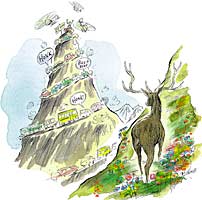Mountain Chronicle Bagging The Fourteeners

Lithe, swift neighbors of mine, Rick Trujillo and Ricky Denesik, have spent the past few summers scaling all 54 of Colorado’s 14,000-foot peaks in record time. In 1995, they bagged the complete list in 15 days, 10 hours and 55 minutes. Last summer Ricky lowered the record to an astounding 14 days and 16 minutes, an average of nearly four summits a day. Clearly, these guys are relatives of Goat Boy.
Another neighbor, Lou Dawson, has climbed and skied from the summits of each of the fourteeners, a feat at least as audacious as the summertime speed marches.
I bring these exploits up only to point out the undeniable and apparently irresistible attraction of numbers. And yet, there is no mathematical magic in the sum 14,000. Like inherited beauty, these mountains have nothing on their less well-endowed brethren but a few extra feet of volcanic upthrust. Still, it has made them famous. And desirable. And now, overrun.
Pike’s Peak, the 14,108-foot monolith that looms most spectacularly from Colorado’s eastern plains, has a graveled (soon to be paved) highway to the top. All but a few of the other fourteeners have developed human highways of their own. Crowded, eroded paths mark the normal route. Hikers above kick down rocks on those below. A school friend of my daughter’s had her thumb severed by a shifting boulder while ascending a rush-hour scree field on 14,150-foot Mt. Sneffels in the western San Juans. Last year, my daughter Cloe and I climbed the same mountain on a warm, clear weekday. We got a 7 am start but still were not first to the top. And we were very soon joined on the lifeboat-sized summit by a dozen other early birds. The summit register was so overstuffed withcandy wrappers and match books that we weren’t eventempted to try to add our names.
All nice people, let me add. But if what you want is less sociology experiment and more an ascent into rarefied alpine beauty, then may I suggest you forget the fourteeners and go climb one of the hundreds, maybe even thousands, of thirteeners, named and unnamed, around the state. You don’t need a map or a marked trail. All you need is a small spark of adventure and a willingness to make like an elk.
Elk and deer have cut intersecting switchback trails, like spiderwebs, across every piece of the mountains that isn’t vertical rock. My two daughters and I found a good one a few years back just up from where the Jeep road we’d been following disappeared in a meadow of waist-high bluebells. We splashed across a rivulet of snowmelt, scrambled over rock blocks that resembled petrified boxcars, and up onto the animal path.
Elk climb at about the same angle as humans in hiking shoes. Back and forth we zigged up a green fell field dotted with blue-and-white colum-bine, wild onions and cushions of moss pink softer than velvet. On the bench above, we stopped for a drink and bonded with a family of ptarmigan, a mama and five mottled, nearly invisible chicks. They seemed unafraid of the girls, allowing a cautious approach to within six or seven feet before calmly walking away.
Up beyond treeline, we had to cross remnant patches of snow pocked with foot-deep sun cups. The elk had preceded us, in early morning when their hooves would not penetrate the frozen crust. We broke through now and then up to our knees, willed ourselves lighter in the thin air, and danced across bright white corn to the snow edge.
Golden-coated marmots, their rock-top sunning interrupted by our approach, piped shrill warnings. Higher still, pikas appeared in a wink then vanished in scree fields like gray-furred leprechauns. Cloe and Cecily sat still as buddhas in promising rock piles until the round-eared critters, mouths stuffed with grass for winter storage, scampered near.
The elk trails, through spongy green tundra, ran all the way to the ridgeline at 12,900 feet. There was no evidence, and no way of knowing, if people had been to this spot before. On the other side was another cirque with fingerrling creeks feeding an alpine tarn, another drainage, another world.
We decided to climb a modest, teapot-shaped plug of rock, a resistant bit of volcanic breccia on our dragon-back ridge. I had brought a piece of rope to belay the girls; the climbing itself was not especially difficult, but the rock was untrustworthy, and the exposure fell away relentlessly on both sides for a thousand feet or more.
It was hard to keep our minds strictly on the climbing; every hand- and foot-hold revealed impossible crevice gardens of pink spring-beauty and sky blue forget-me-nots.
Psychedelic, safety-orange lichen splashed the gray composite.Finally, safely on top (13,34-something by the topo map), the land fell away in all directions. We were angels on a pin point thrust into the sky. We sat and dangled our feet off the edge. We stared at a golden eagle soaring the updrafts, racing the gathering thunderstorms. We, too, would have to leave soon. We could hear thunder and thought we might even be feeling the rumble under our seats. We would dash down ahead of the lightning, skid across the snow and bound down the elk paths to the safety of the bluebell meadows.
Before we left, though, we needed to name our little spire. “Pika Peak” came the unanimous chirp from the girls. And so it is. And shall always be, more famous in our memories than any celebrity-trammeled fourteener.